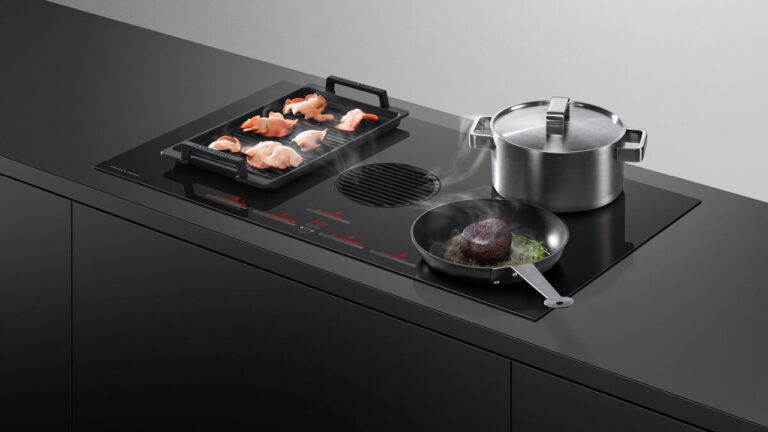Among the numerous design solutions previewed at this year's Kitchen & Bath Industry Show (KBIS), one piece of equipment that struck us as an option that could revolutionize kitchen layout, design, and air quality while cooking was the downdraft ventilation system. Installed alongside an induction cooktop, this setup virtually eliminates the need for a traditional overhead hood, resulting in a sleek, minimalist layout that can suck in steam, smoke, and odors generated while cooking. It's an ideal complement to kitchen technologies that are already improving air quality in the home. Examples of this style of kitchen equipment include: Fisher & Paykels latest 36-inch ventilated induction cookerDesigned for flush or raised countertop installation, Fisher & Paykel's 4-zone induction cooktop features nine fan settings that match well with the appliance's nine induction heat settings.

Located in the center of the cooktop, the exhaust system can suck in everything from the gentle steam that comes from a boiling pot to the smoky particles that come from searing meat and grilling vegetables.

The absence of a traditional large hood overhead means one less large surface to clean, improving sightlines, use of natural light and the overall layout of the kitchen.

Rated at 413 cubic feet per minute (CFM) in maximum boost mode, the ventilation system is comparable to a traditional range hood that is typically paired with an electric or induction cooktop, with the vent itself being closer for better suction.

At its lowest setting, the fan produces a noise output of 1.83 sones, which is just a little louder than a refrigerator. Even at its highest setting of 9, the fan still puts out an audible output comparable to normal conversation or light traffic noise, which is certainly an improvement over the jet engine noise you typically endure when cooking with a ceiling fan on its highest setting.

At KBIS, we noticed many attendees feeling a mixture of awe and odd delight as they watched steam and smoke being blown directly down from the cooking surface rather than from overhead. More than just a novelty, this new generation of downdraft vents produces ample cubic feet per minute of suction while facilitating an integrated design that complements induction technology's sleeker surface designs.

As with induction technology, downdraft ventilation systems are the exception, not the rule, in kitchen design. They require installers to install rear ducting to safely direct airflow outdoors. They also come at a higher price, with Fisher & Paykel's 36-inch induction cooktop starting at $6,199.

While most kitchens are designed for an overhead range hood, Fisher & Paykel's integrated ventilation systems are ideal for new builds, kitchens with high ceilings where a ventilation hood is impractical (and an eyesore), and major renovation projects where planning and installation can be tailored to fit counter space and room layout.
For more information on Fisher & Paykel's newest 36-inch induction cooktop with venting, visit fisherpaykel.com.



